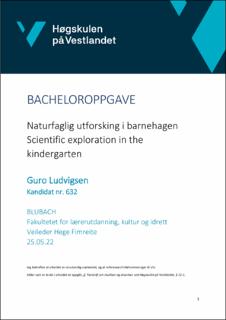| dc.description.abstract | This bachelor thesis addresses questions aimed at how kindergarten teachers work with scientific exploration, in the form of facilitating the physical environment within the kindergarten's fences. By focusing on this, I want to shed light on something that kindergartens should work with, although it might be something that goes its way in everyday life without much reflection on why and how it is done. A lot of the previous research on the topic refers to, amongst other things, the importance of the physical environment, especially the motor and physical health effects of the outdoor environment for children. However, there is less research on the environmental impact of children's scientific exploration. Where research on this is found, it is often in connection with nature playgrounds, which is natural, as this is where we find the best opportunities for scientific exploration. But what about inside the fences? 5 Considering the topic, I chose the issue "How do kindergarten teachers facilitate scientific exploration in the outdoor area?" To answer this issue, I have used a hermeneutic and phenomenological view of knowledge aimed at qualitative research methods with observation and group interviews. This is done in two kindergartens, where Kindergarten 2 focuses on being in nature with the children, whereas Kindergarten 1 points their attention at other focus areas. There are two informants who represented each kindergarten, and the interview was semi-structured. I transcribed along the way. Throughout the research, I have used a knowledge base that addresses a previous research and theory part, where I have seen these together with the results during the interview to get my results. In my research, it turns out that considering affordances, the dwelling perspective, children's physical play and behavior, kindergarten teachers facilitate scientific exploration by emphasizing trees, shrubs / hiding places, streams, and species richness that offers complexity with variation possibilities (Osnes et al. 2015 p. 15-16 in sb; Bagøien & Storli, 2019, p. 13). Since this is a dynamic environment with natural loose- and reusable materials attractive in facilitation, you will, in conjunction with digital tools and other tools, arouse curiosity and wonder. This will prolong and deepen the children's commitment to scientific exploration (Bjønnes, 2014, p. 223; Langholm, 2017, p. 122). | en_US |

